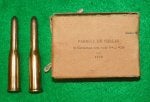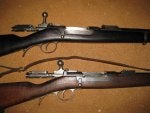Hey all,
I'm sure this is covered somewhere here, but can't find it. After watching Othias discuss the Krop on C&Rsenal, I found one for not much money and have some questions about ammo.
I see that 8x56rs is available through several suppliers. Am wondering if I might shoot this initially through the Krop then reload with round nosed bullets for more accuracy. If so, does anyone know the smokeless powder load and RN bullet size for the original smokeless Krop 8x56R round?
Greg
I'm sure this is covered somewhere here, but can't find it. After watching Othias discuss the Krop on C&Rsenal, I found one for not much money and have some questions about ammo.
I see that 8x56rs is available through several suppliers. Am wondering if I might shoot this initially through the Krop then reload with round nosed bullets for more accuracy. If so, does anyone know the smokeless powder load and RN bullet size for the original smokeless Krop 8x56R round?
Greg













